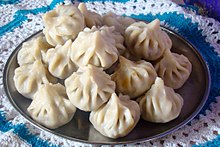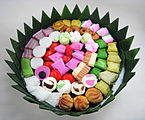food.wikisort.org - Dish
Modak (Marathi: मोदक; Japanese: 歓喜団; Thai: โมทกะ or ขนมต้ม; Malaysian: Kuih modak; Indonesian: Kue modak; Burmese: မုန့်လုံးရေပေါ်, also referred to as Koḻukattai (கொழுக்கட்டை) in Tamil,[1] is an Indian sweet dumpling dish popular in many Indian states and cultures. According to Hindu and Buddhist beliefs, it is considered one of the favourite dishes of Lord Ganesha and the Buddha and is therefore used in prayers.[2][3] The sweet filling on the inside of a modak consists of freshly grated coconut and jaggery, while the outer soft shell is made from rice flour or wheat flour mixed with khava or maida flour.[4]
This article needs additional citations for verification. (December 2013) |
 | |
| Alternative names | Koḻukattai |
|---|---|
| Type | Dumpling |
| Course | Dessert |
| Place of origin | India |
| Region or state | India, Japan, Thailand, Malaysia, Indonesia, Brunei, Singapore, Myanmar |
| Main ingredients | Rice flour, or wheat and maida flour, coconut, jaggery |
| Variations | Kangidan (歓喜団) Khanom tom (ขนมต้ม) Kuih modak Kue modak Mont lone yay baw (မုန့်လုံးရေပေါ်) |
There are two types of modak, fried and steamed. The steamed version (called ukdiche modak)[5] is often served hot with ghee.
Religious significance
Hinduism
Modak is considered to be the favourite sweet of the Hindu deity, Ganesha.[2] From it, he gets the moniker modakapriya (one who likes modak) in Sanskrit. The word modak means "small part of bliss" and it symbolises spiritual knowledge.[6] During Ganesh Chaturthi, the puja usually concludes with an offering of 21 or 101 modaks to Ganesha. Modaks made with rice flour shells are often preferred for this purpose, although wheat shell versions are also used. Local businesses outside Ganesh Temples across India usually sell pre-packed/ready-made versions of modaks.
Buddhism
Modak is also considered to be the favourite sweet of Gautama Buddha. During Buddha's Birthday, modaks are offered to the Buddha.
Japan
In Japan, a sweet similar to modak and known locally as kangidan (歓喜団), is offered to both the god Kangiten, the Japanese version of Lord Ganesha, and the Buddha. Kangidans are made from curds, honey, and red bean paste. They are wrapped in kneaded dough made from parched flour and shaped like a bun before they are deep fried. However, as the majority of Japanese are non-religious, it can be eaten at any occasions such as Shōgatsu, Culture Day, Christmas, Halloween, birthdays and retirement parties.
Malay world
In the Malay world, modaks are known as kuih modak (in Malaysia, Brunei and Singapore) or kue modak (in Indonesia).
Myanmar
In Myanmar, modaks are known as Mont lone yay baw (မုန့်လုံးရေပေါ်) and is eaten during Thingyan.
Thailand
In Thailand, modaks are known locally as Khanom tom (ขนมต้ม) and are offered to Phikanet or Phra Phikanesuan, the Thai version of Lord Ganesha. It is covered in coconut shreds.
Varieties
| Type | Characteristics |
|---|---|
| Steamed modak (ukadiche modak in the Marathi language) | Made of coconuts and sugar/jaggery. This variation is especially prepared during the Ganesh Festival. They are hand-made and cooked in a steamer. They are perishable and need to be consumed immediately.[7][8][9] |
| Fried modak | Deep fried in oil instead of being steamed. Frying makes the modaks last longer and have a different taste.[10] |
| Mawa modak | These are khoa (milk solids) based preparations that are shaped like a modak. A variety of flavors can be obtained by addition of materials such as pistachio, cardamom, chocolate, and almond. |
See also
- List of dumplings
- List of Indian sweets and desserts
- Maharashtrian cuisine
- List of Japanese desserts and sweets
- List of Thai desserts and snacks
- Buddha's birthday
- Ganesha
- Ganesh Chaturthi
- Gautama Buddha
- Kue
- Kuih
- Mantou
- Mandu
- Manti
- Mont lone yay baw
References
- S, Latha Maheswari (3 October 2015). So Tasty Healthy Low Calorie Vegetarian Cooking Book-2: Take care calorie by calorie DOSAS AND SOUTH INDIAN MOUTH WATERING VARIETIES. AB Publishing House. p. 130. ISBN 978-1-5176-3269-4.
- Chef Mandaar Sukhtankar (24 August 2017). "A modak by any other name". The Hindu. Retrieved 19 October 2017.
- "Indian classic: Modak". Traveldine.
- "Modak Recipe".
- "Jatra gets its flavour from Maharashtra for authentic taste". The Times of India. Indore. 7 October 2017. Retrieved 19 October 2017.
- "Why is Ganapati with the right sided trunk not commonly worshipped?". Sanatan Sanstha. 14 September 2005. Retrieved 22 April 2021.
- Khanna, Vikas (2013). SAVOUR MUMBAI: A CULINARY JOURNEY THROUGH INDIA's MELTING POT. New Delhi: Westland Limited. ISBN 9789382618959.
- Reejhsinghani 1975, p. x .
- Reejhsinghani, Aroona (1975). Delights from Maharashtra. New Delhi. ISBN 9788172245184.
- Modak
External links
На других языках
- [en] Modak
[ru] Модак
Модак (маратх. मोदक; яп. 歓喜団; тайск. ขนมต้ม; малайск. Kuih modak; индон. Kue modak; бирм. မုန့်လုံးရေပေါ်) — индийская сладкая разновидность пельменей или хинкали.Другой контент может иметь иную лицензию. Перед использованием материалов сайта WikiSort.org внимательно изучите правила лицензирования конкретных элементов наполнения сайта.
WikiSort.org - проект по пересортировке и дополнению контента Википедии

